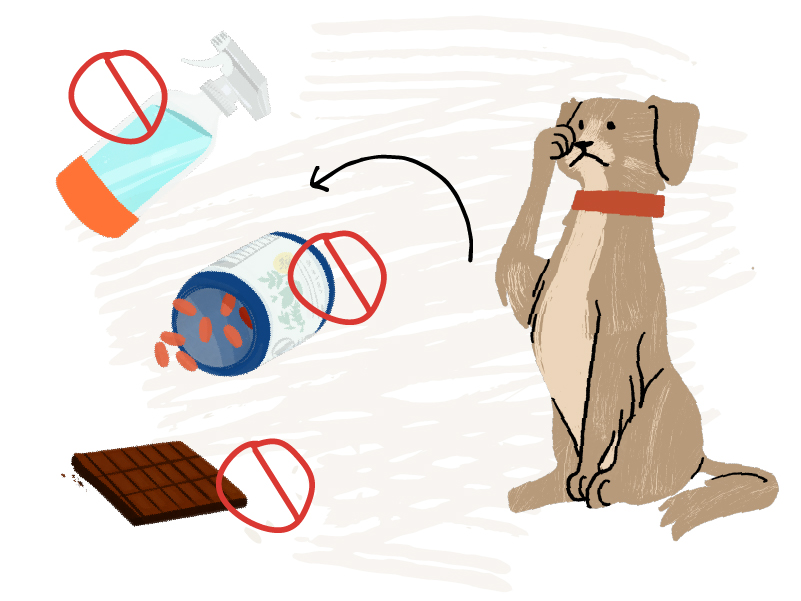
Ticks are small parasites that feed on warm-blooded animals, including dogs and people. Your dog is most likely to pick up ticks while walking through grass or wooded areas. Ticks can’t jump or fly, so they cling to brush and vegetation and transfer to a host when it passes by.
As a dog parent, knowing how to find and remove ticks is important because ticks can transmit several different diseases. Keep reading to learn how to identify and avoid ticks, and what to do if you find a tick on your dog.

Spotting Dog Ticks
To inspect your dog for ticks, start by running your hands and fingers through your dog’s coat, feeling for any small bumps. Take a close look at the places where ticks most commonly attach to dogs:
- In & around your dog’s ears
- Eyelids
- Tail
- Under the collar
- Where your dog’s legs meet the body
- Groin area
- Between your dog’s toes
Ticks resemble insects, but they’re actually arachnids (like spiders). Ticks can have a hard or soft body, and their appearance can change throughout their life cycle. In general, the ticks you find on a dog will be small, dark-colored and oval-shaped — if you look closely you can spot four pairs of legs. Before feeding, a tick’s body will be relatively flat, but they become engorged after eating a blood meal and can swell to the size of a pea.
There are many different types of ticks in North America, but the ticks you’re most likely to find on your dog are American dog ticks, brown dog ticks, lone star ticks, and deer ticks. It’s worth spending some time researching the types of dog ticks most common in your region and what they look like.
Check your dog for ticks daily if they’ve spent any time outdoors. If a tick is allowed to remain attached to your dog it can continue feeding on blood for up to a week before dropping off. The longer a tick is on your dog, the greater the chance of disease transmission.
Symptoms when dogs have ticks
There are multiple tick-borne illnesses that can affect dogs. Here are the most common types of diseases that can spread from ticks to dogs, along with their symptoms:
Bacterial infections
Bacterial infections can enter the bloodstream via tick bite and cause a wide range of health issues.
- Lyme disease symptoms in dogs include swollen lymph nodes, swollen joints, fatigue and weakness, and loss of appetite. Unlike humans, dogs usually don’t get a “bullseye rash” from Lyme disease. Dog ticks and lone star ticks don’t carry lyme disease, but deer ticks do.
- Canine bartonellosis symptoms include fever, muscle pain, swollen glands, discharge from the nose, nosebleeds, difficulty breathing, and digestive upset.
- Rocky Mountain spotted fever symptoms include swollen lymph nodes, joint pain, loss of appetite, fever, and balance issues.
- Tularemia symptoms include swollen glands, a sudden high fever, weakness, and loss of appetite.
- Canine ehrlichiosis symptoms include fever, nose bleeds, loss of appetite, and easy bruising.
- Canine anaplasmosis symptoms include fever, weakness, loss of appetite, stiff joints, digestive upset and seizures (in severe cases).
Protozoal infections
Protozoa are single-celled organisms transmitted by ticks that can cause tissue damage and disease.
- Canine babesiosis symptoms include jaundice (yellowed skin and eyes), pale gum tissue, dark urine, weakness, and sometimes vomiting.
- Canine hepatozoonosis symptoms include pain in the bones, joints, and muscles, fever, pale gums and swollen glands.
If your dog becomes infected with a tick borne disease, symptoms can appear anytime between 3 and 30 days after the tick bite. Some diseases (including Lyme and Rocky Mountain spotted fever) can lead to chronic long-term health issues or even be fatal if they’re not treated.
Can dog ticks make people sick?
Absolutely. Dog ticks carry diseases that can affect both dogs and people. But you can’t get a tick-borne disease from your dog: you’re only at risk if a tick attaches itself to you.
People can pick up ticks the same way dogs do, by encountering them in grassy or wooded areas. Ticks can also detach from your dog and crawl onto you instead. Make sure to regularly check yourself for ticks, including your body, your clothing, and gear like leashes or backpacks.

Removing Dog Ticks
You’ve found a tick on your dog – now what? First, gather some supplies to protect yourself and make tick removal easier:
- Latex or nitrile gloves
- Tweezers or tick removal tool (like a tick key)
- Rubbing alcohol
- Antiseptic
Wearing gloves, use tweezers to grab the tick’s body as close to your dog’s skin as possible without pinching them. If using a tick remover, press it against your dog’s skin alongside the tick, then slide it so the notch is under the tick’s body.
Pull using slow and steady force, in a straight line (don’t wiggle back and forth or pull with a sudden jerk). This gives you the best odds of getting the whole tick out.
When the tick is off, put it in a small container with rubbing alcohol in case your veterinarian needs to examine it later. Clean your dog’s skin with antiseptic, and clean your tweezers or tick key with rubbing alcohol. Wash your hands with soap and water after removing your gloves.
Be careful not to crush or puncture the tick’s body while you’re removing it, because disease can be transmitted from the tick’s bodily fluids. If the tick’s head or mouth parts are still in or under your dog’s skin after removing the tick body, leave them alone and they should eventually work their way out. Never attempt to dig them out from under the skin because this can hurt your dog and increase the risk of infection.
Drowning Ticks
There’s a common misconception that you can smother a tick while it’s still on the skin by covering it in butter, petroleum jelly, nail polish, or any number of substances. In reality, attempting to “drown” or suffocate a tick will only make it burrow in deeper to try and escape the threat.
To kill a tick after removing it, you can drown it in rubbing alcohol, freeze it, throw it in a fire, or seal it in a bag or jar. Don’t smash or cut the tick because there’s a risk of its bodily fluids spreading infection.
If my dog has a tick should I take them to the vet?
It’s generally not necessary to take your dog to the vet after removing a tick because the tick bite should heal on its own. Just keep an eye on the area where your dog was bitten, note the date the tick was removed, and monitor for signs of skin infection or tick-borne disease.

Preventing Ticks on Dogs
There are many different types of tick prevention products for dogs, including oral medications, topical treatments, medicated collars, shampoos, sprays, wipes and yard treatments. You should consult your veterinarian to determine which method of tick prevention is best for your dog.
If your dog loves spending time in your yard, you can reduce the risk of tick exposure by keeping the grass cut short and providing an outdoor dog bed.
Be extra vigilant around tick exposure in warm weather, but know that dog ticks can still be active throughout the fall and winter. Some ticks survive cold temperatures by attaching themselves to a host, so if your dog spends time in areas with wildlife they could potentially pick up a tick even in the winter.
Now that you know how to prevent and remove dog ticks, you’re ready to learn how to camp with your dog! If camping isn’t in the cards for your pup, check out our guides to walking your dog in hot weather, and when it’s too cold to walk your dog.
GET $3 OFF, INSIDER OFFERS, AND HELPFUL PET CARE TIPS.
By entering your information, you are opting in to receive communication from Stella & Chewy's





